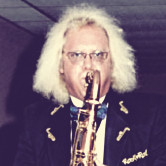I’m sure that the saxophone world was in an absolute state of shock when the Mk VI was introduced in 1954. Here was an instrument that was light years ahead of anything else available up to that time, both in terms of sound and in terms of ergonomics. There was nothing else available on the market at the time that could match the feel or the performance. So did the players of the day immediately dump the horns they had been using to take up the “latest and greatest”? No, for a variety of reasons. First, and probably foremost, a new horn is a major expenditure that very few players can easily afford. Secondly, I suspect that quite a few players were simply happy with their existing equipment, and had learned how to deal with its shortcomings. Of course, over time, more and more prominent players switched over to the Mk VI, and by the time that production stopped after 20 years, it sees like most everyone was playing one.
By the mid 1970’s Selmer was having a difficult time selling MK VI horns, and offered them at deep discounts. The simple fact of the matter is that there were far too many of essentially the same thing available on the used horn market at much lower prices than Selmer dealers were asking for new ones. Remember that these horns were made not in the thousands, but in the tens of thousands, so there were always plenty of used ones floating around. Oversupply will drive the price down pretty much every time.
Was there anything unique about the Mk VI? Not really…..it was the state of the art at the time it was in production, but all of the good qualities can be and are currently being duplicated. This duplication is not rocket science. Were there unique material used (artillery brass?) that are not available today? In a word, no. Was the skill level of the workers building the horns superior to what is available today? You’re kidding, of course…..except for a very few specialty skills like engraving, the assembling of saxophones is pretty basic manufacturing and metal working, and is easily taught to just about anybody. The trick is good initial design and good quality control.
Today, the Mk VI is still the horn of choice for many players. You have to ask yourself why, since even the very best ones are far from perfect. I think a large part of the reason is simple nostalgia: “Coltrane or (insert long dead saxophone players name here) sounded great, and if I use one, so will I”. Well, maybe yes, or maybe no. The next reason is habit. Lots of people playing Mk VI horns today have owned them for years, and see no reason to change. The final reason is economic: many Mk VI believe that their horns are going to appreciate in value (just like real estate, huh?) and that even the worst one that has been re-lacquered three times, has the engraving buffed down to nothing being as smooth as a baby’s butt, and has the pearl holders worn down to an exquisite thinness is worth $10,000. If they’re lucky, they bought the horn in the period following the end of production and the late 1990’s, when speculators drove prices through the roof. I’ve bought more than a few for less than $300. Are the horns worth the stratospheric prices some wildly optimistic sellers ask? No, although really pristine examples still bring top dollar.
As a matter of disclosure, I got my first Mk VI in 1964, brand new (gift from my father for making first chair in the all state band) and have bought and sold hundreds of them of all varieties over the years. They were my main gig horns for 30 years.
I know that some of the current users will consider my thoughts blasphemy. “Well, my (insert serial number or year of manufacture) has a sound that just cannot be duplicated with modern horns” or “the old craftsmen built much better horns” or some other such denial of fallibility. That’s fine, believe what you will. I leave you with this analogy, since the Indianapolis 500 is coming up in a couple of weeks:
If you were going to enter this years race, would you prefer to compete with a car built in 1954 or 2012? The answer strikes me as obvious…..
The Mk VI Mystique

Want to Talk About It? Visit Our Discussion Groups on Facebook!

